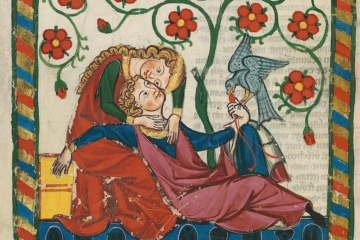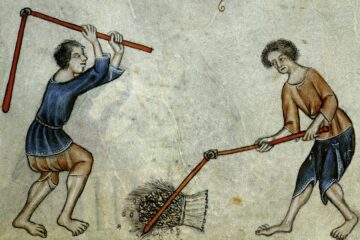by Harry Gulcher, Master of History in Rosewood
The Iberian Peninsula has always been known for its unusually high number of Muslim inhabitants, given that it is part of Europe. The Arabian Moors are what the Sevillian King would consider the “invaders”. Truth be told, Mateo II, in all his wisdom failed to see that those people he thought were a plague on our fine continent are ordinary citizens who have jobs, dreams, crafts, and aspirations like the rest of us. He should have shifted his focus towards his real enemies, the Sultans who wanted him dead, so much so in fact that they sent assassins to kill him, three times in 1096.
Those attempts on his life were the drop that spilled the cup. King Mateo II ordered all the Jews and Muslims to be expelled from his lands. The Sultan of Granada Abdallah IV decided to retaliate with a jest, he had one of his bards compose a mocking tune to be played at all future feasts. That tune was aimed towards the King of Seville. Granada’s neighbor and its Sultan, Muhammad II did not take as kindly. In 1097 the Sultan of Almeria ordered all the Christians to leave his realm and enter into Seville.
After both parties refused to negotiate and take back the words said, one can only assume that war was declared. Sultan Abdallah had no choice but to side with his ally Almeria, and as such went to seek the aid of the Moroccan Sultan, Abu-Bakr I. Mateo also mustered his own allies, but his greatest move was calling for the Pope’s aid. His Holiness Pope Clement II saw an excellent opportunity in seizing land and making allies, so instead of just declaring war, he called for a Crusade.
And so by the 18th November 1099, holy war had been declared. The Third Crusade, also known as the Reconquista. It saw a huge conflict between the Christian Kingdoms:
-Seville
-Castile
-Lisboa
-Navarra
-The Papal State
-Pisa
-The Knights Divine
And the Muslim Sultanates:
-Granada
-Almeria
-Tortuga
-Valencia
-Morocco
-Mzah
-Tunisia
With some aid from the Fatimids.
All in all, both sides had around 15.500 men, with the Muslim forces, slightly outnumbering the Crusaders.
King Mateo II, even though some consider him a fool, made a crucially beneficial decision at the beginning of the war. He surrounded himself with expert advisors who would help him win the war. The battles are fairly documented and the numbers seem to be precise on both sides.
The Battle of Gibraltar, 25th March 1100
Given the scale of the conflict, it took some time for the respective forces to arrive at their destination. The first battle of the war was a naval one. It served to answer the question of “who controls the sea?”. Morocco decided it wanted to control it and attacked the Crusader fleet, commanded by Lisboa. In the battle, Morocco lost 50 ships, while Lisboa lost 130 to fire and another 100 to desertion. This battle would cripple the Crusader fleet for the rest of the war, meaning no landing in Tunisia or Morocco would be possible. This gave the Crusaders the objective of taking the Iberian Muslim states and holding onto them until the rest of the Muslims became tired and were forced to accept a peace treaty.
The Battle of Granada, 3rd June 1100
With all possibility of a landing taken away, King Mateo II decided to attack Granada directly and take it before the Muslims had any time to organize better. His attempt was successful and the numerically superior Muslim force was beaten by the Crusaders near Granada. The Muslims lost 750 and 200, while Seville lost only 50 men. A resounding victory that bolstered the morale of the Crusaders. God favored them at that point surely.
The Siege of Granada, 10th June 1100
After driving away the Muslim forces, the Crusaders decided on besieging their holdings in Granada, hoping to knock them out of the war within the first year of fighting. Siege engines were made and the roads cut off and burned. After 145 days of siege, Seville failed and the besieged were able to drive them away. During those 145 days, the Crusaders lost around 1544 men to disease and hunger. This would mark an opportunity for the Muslim army to strike.
The Battle of Seville, 2nd March 1101
The wise Sultan Abdallah IV knew not to attack the Crusaders, even in their moment of weakness. Instead, both sides bided their time until they had regained most of the losses they had suffered when the war began. The Muslim forces pushed into Seville with their entire military force, hoping to draw out their enemy in the open and end the war with one decisive battle. Their wish was granted. King Mateo II answered the call and rode to meet them in battle near his capital. In the end, the clash resulted in a Granadian victory. They lost only 800 and 600, while the Crusaders suffered a loss of 2.100 and 500, a crushing blow. At this point, most of the voluntary forces were depleted and the main army branch was low on both morale and supplies. Mateo II, instead of having his city besieged for another year, and perhaps drawing out the conflict for 2-3 more years, decided to sue for peace.
A peace was signed on the 15th April 1101, which marked the end of the war. Both sides got something, but the Muslim forces definitely got the longer end of the stick. King Mateo II knew that he couldn’t have had a quick and easy war, so in his mind, he decided he would lick his wounds and try his luck again, in a second war for Granada. He passed away before he could live those dreams and his son, Mateo III took the throne and signed a peace treaty with the Muslim Sultans, hoping to avert any future wars. It would seem his son is somewhat of a pacifist. The Third Crusade was the first and only one to end in failure, for Granada stands on the map to this very day.


